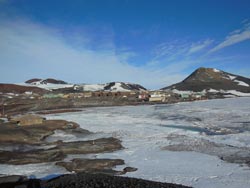Change of Venue for NASA's IceBridge Antarctic Operations

View of McMurdo Station from Hut Point.<br>Image Credit: NASA / Christy Hansen<br>
“Antarctica is a big place and there are many science targets for us to hit,” said Tom Wagner, cryosphere program scientist at NASA headquarters, Washington.
This change comes after nearly a year of planning and collaboration between NASA and the National Science Foundation or NSF, to ensure that the station could support IceBridge's personnel, equipment and aircraft requirements.
NSF oversees all U.S.-based scientific expeditions in Antarctica and the U.S. Antarctic Program and Antarctic Service Contract manage operations at McMurdo Station. Because of this, IceBridge planners worked closely with NSF, U.S. Antarctic Program and Antarctic Service Contract personnel to arrange the upcoming campaign.
“It is fantastic to see how NSF, ASC, the Air National Guard and NASA have worked together to make this happen,” said Michael Studinger, IceBridge's project scientist at NASA's Goddard Space Flight Center in Greenbelt, Md. “The NASA P-3 adds tremendous capabilities to the existing suite of research aircraft that have been used for science data collection over Antarctica.”
“The initial challenge was trying to comprehend and identify all of the requirements, constraints and factors of operating science instruments and a wheeled aircraft in a complex and remote environment,” said Christy Hansen, IceBridge's project manager at NASA Goddard. “We've been working on this in the background during our last two campaigns.”
Late in 2012, NASA representatives traveled to Antarctica to document available resources at McMurdo Station, meet with station personnel and get a better understanding of NSF's regulations. The representatives also verified availability of housing, food and transportation. They checked to ensure IceBridge could operate the mission's aircraft, instruments and equipment without placing an undue burden on NSF or other scientific operations there.
After returning from Antarctica, IceBridge mission planners, instrument teams and the aircraft office at NASA's Wallops Flight Facility in Virginia continued working with NSF to document the mission's requirements. This included working out an accurate headcount for scientists, instrument operators and flight crew and making sure that there would be enough fuel and storage space for the P-3 and the equipment needed to maintain it. Because McMurdo is a remote location the team needs to secure spare parts for any necessary repairs.
While this planning work was taking place, aircraft technicians at Wallops were upgrading the P-3 aircraft so it would meet NSF's requirements and be optimized for flying in Antarctica. Among the upgrades are new flight management and synthetic vision systems and updated satellite communication hardware. “The new flight management and synthetic vision systems will provide the P-3 the ability to perform GPS approaches into airports worldwide and improve reduce visibility landing capabilities,” said Mike Cropper, aircraft operations manager at NASA Wallops.
In late October 2013, IceBridge will start survey flights out of McMurdo with the P-3. Flying out of Punta Arenas, Chile, allowed IceBridge researchers to measure portions of West Antarctica and the Antarctic Peninsula. However, there is less information on areas like the Ross Ice Shelf and portions of East Antarctica. “The Ross Ice Shelf is the size of France and poorly understood,” Wagner said.
Having better data on these areas would improve knowledge of how the ice shelf interacts with nearby ice streams and what is happening to the continent's ice mass balance as a whole. “Operating the P-3 from McMurdo has the potential to turn into a real game changer for airborne science in Antarctica and will create many new opportunities for science data collection,” said Studinger. “It will now be possible to collect data over areas that have been difficult and costly to reach.”
For more information on Operation Ice Bridge, visit:
www.nasa.gov/icebridge
George Hale
NASA's Goddard Space Flight Center, Greenbelt, Md.
Media Contact
All latest news from the category: Earth Sciences
Earth Sciences (also referred to as Geosciences), which deals with basic issues surrounding our planet, plays a vital role in the area of energy and raw materials supply.
Earth Sciences comprises subjects such as geology, geography, geological informatics, paleontology, mineralogy, petrography, crystallography, geophysics, geodesy, glaciology, cartography, photogrammetry, meteorology and seismology, early-warning systems, earthquake research and polar research.
Newest articles

Bringing bio-inspired robots to life
Nebraska researcher Eric Markvicka gets NSF CAREER Award to pursue manufacture of novel materials for soft robotics and stretchable electronics. Engineers are increasingly eager to develop robots that mimic the…

Bella moths use poison to attract mates
Scientists are closer to finding out how. Pyrrolizidine alkaloids are as bitter and toxic as they are hard to pronounce. They’re produced by several different types of plants and are…

AI tool creates ‘synthetic’ images of cells
…for enhanced microscopy analysis. Observing individual cells through microscopes can reveal a range of important cell biological phenomena that frequently play a role in human diseases, but the process of…





















